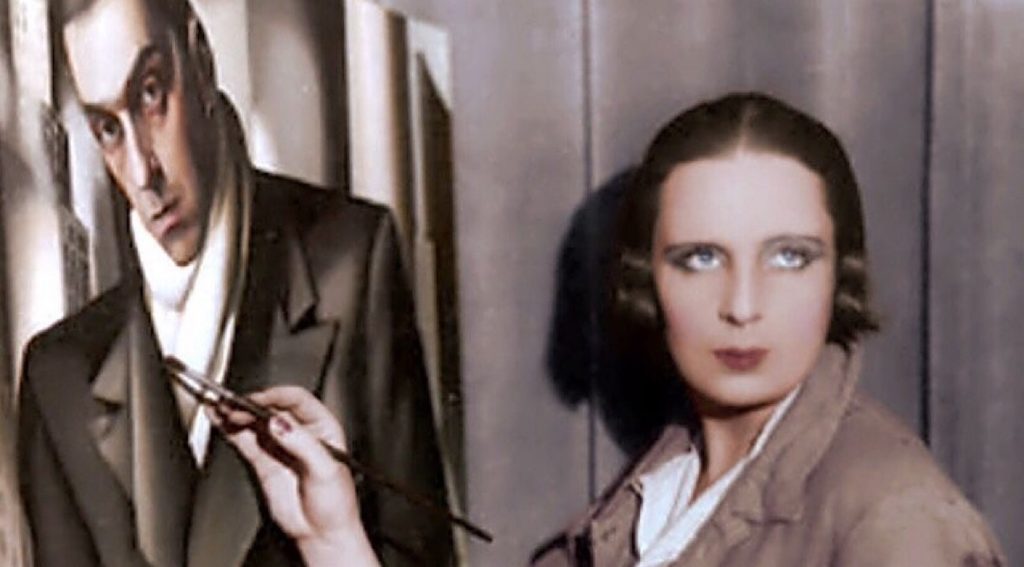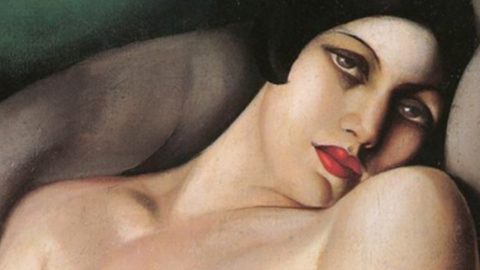Everything originated from its origin, where a decadent and symbolist aesthetic of Russian origin was opposed to futurism according to the interpretation of Valentine de Saint-Point, author of Mfuturist anifesto of Lust.
Born in Warsaw in 1898, she then moved to St. Petersburg with the first name, Gorska. She shortly she married Tadeusz Lempicki, a young man, a law graduate, a lover of women and wasted time, hence he abandoned his surname to take that of her husband and moved to Paris, it was 1919.
Her passion for art was almost "carnal" and in just a few years, from 1919 to 1922, she managed to master the craft as a great professional. Of her Early paintings of her as: The two friends or La woman in a black dress they were already works of great chromatic composition, typical of Tamara's art.
His figure is overwhelmingly visual, where a certain deformation enters the curved conducting lines that draw circles and arcs. The subject almost looks like a sculptural composition according to a lesson, the Cubist one.
He doesn't use many colours, the canvases often use the same colours, black with gray serves to tone down the strongest relationships, faces with evident eye sockets marked by sharp brow arches, dark make-up which recalls the use of Marlene Dietrich to spread the ash of cigarettes dissolved in coffee on the eyelids.
He attended two schools of two artists: Maurice Denis, symbolist painter, e Andre Lhote, trained as a cubist who in 1922 founded the Odessa school in Montparnasse. Tamara inherits from both of her masters, the search for style which necessarily becomes control of the image, a tumult of passions capable of involving the viewer. This is how Tamara's characters become immobile statues, female mannequins with an ambiguity played on their gazes.
Pictorial intelligence is for the artist a sort of balance that must eliminate everything that appears vulgar, and he succeeds with great refinement. Interesting are the arabesques of faces that we find in Tamara's paintings of the 20s, such as The head of a Slavic woman which recalls certain faces of Bronzino or models of Pontormo.
Tamara throughout her life tried to portray characters who had a story almost capable of influencing the painting, as if she wanted to transfer their fame to give glory to her work, or that the same was capable of reflecting it.
In 1925 he painted a few portraits including The portrait of the Marquis Sommi, where geometry and lines combine a figure placed almost on asymmetrical planes, such as to break the picture into different superimpositions and where the hand – with a gold ring with an emerald in the center – resting on the arm and the face with features quite feminine.
In the second half of the 20s, Tamara was absorbed in the search for the "pictorial rhythm" resulting from Lhote's theory. In the painting "Group of four nudes” we find a system of lines, arcs and ovals, precisely through the profiles and shadows of the bodies.
Observe later Ingres, the portrait painter of the nobles and the upper class, in his attempt to find an ideal of Intellectual Style. In Tamara's later works, we find the aesthetic ideals of Ingres, the more the lines and shapes are simple, the more there is beauty and strength, and the color adds ornamentation but she is nothing but a lady-in-waiting.
Tamara loves gray for the backgrounds of her paintings, but also for the architecture, the gray walls of her house and also of the galleries where she exhibited. That gray balance and harmony of Florentine architecture that we find behind the portraits of Pontormo.
In the following years the naked characters dress heavily with squared and voluminous clothes that hide the bodies and sublimate them to the point of making one believe that the dress is almost a wet veil that adheres to the skin, such as for example girl with gloves, where the green dress rests on the body and enhances its anatomical parts, but without ever any hint of vulgarity, everything appears natural.
While others like Portrait of Madame Allan Batt from 1930, the figure has an elegant plasticity, almost a dance of folds of the silver-grey dress wrapped in a red stole with fur and in the background tall American skyscrapers immersed in the night.
In those same years, the issue of lesbianism was very topical, regardless of Lempicka's propensity. An example is found in the first edition of the Research by Marcel Proust, in which several episodes of female love are described. Middle-class women who animate the intellectual life of the "Left Bank“. Tamara in 1933, dedicates a portrait that is presented to all the Paris that matters to her.
In a certain moment, we are in 1933, Tamara begins to paint pictures with religious subjects, and the same year she exhibits at the Tuileries Hall a Giovanna D'Arco while hearing the voices. A painting that intends to remove high society, preferring the marginalized. Other paintings are, St. Anthony, St. John Baptist, all examples of a strong pictorial change by the author.
From here begins a period for Lempicka where the inspiring force fades and becomes even more evident in the US period, where she had moved since 1939. She paints still lifes where an evident tiredness of manner is revealed, the eyes are clouded and far from the Parisian period. In the 40s and 50s you communicate only a firm, immobile tone, where the plasticity appears almost awkward.
He ended his career and life by repainting works by the "année follies" in Paris. She copied them from photographs but nothing could be as before.






